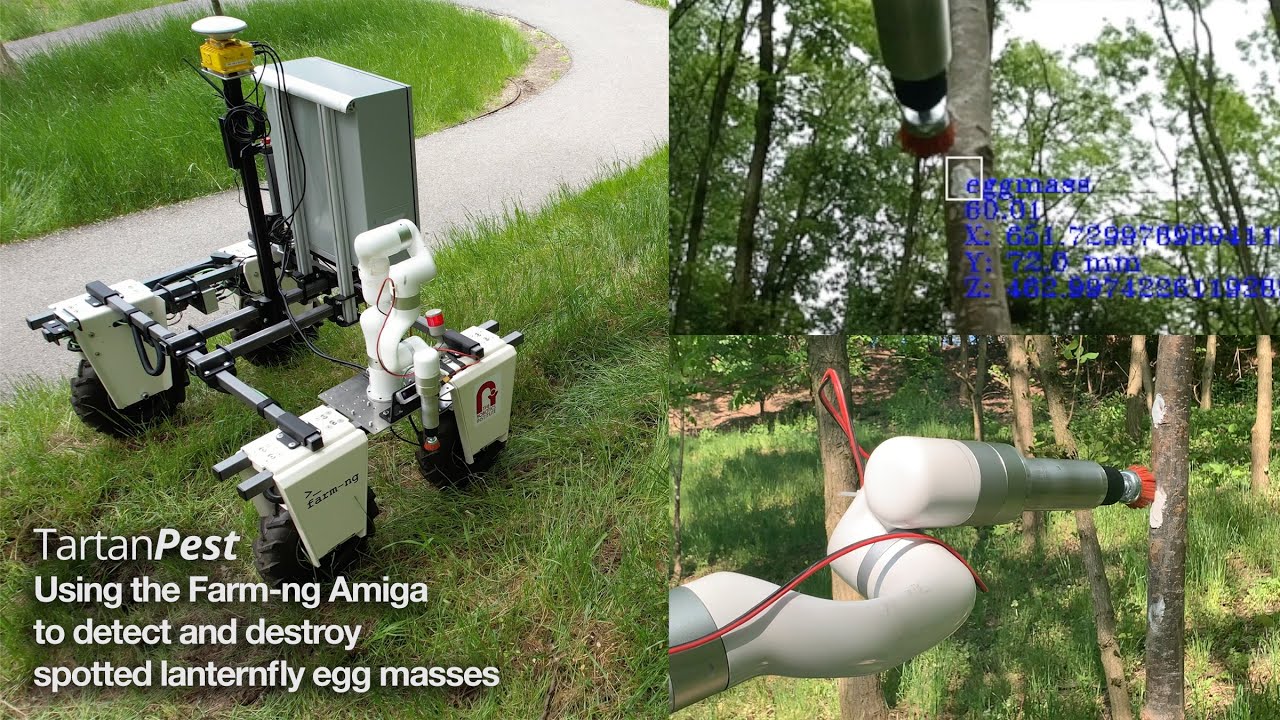
TartanPest pairs computer vision with a robotic arm attached to an electric tractor to detect and destroy spotted lanternfly egg masses.
A team from Carnegie Mellon University’s Robotics Institute has developed an autonomous robot to control the spread of spotted lanternflies, invasive insects known to destroy economically important crops.
TartanPest uses an all-electric tractor, a robotic arm and computer vision to traverse fields and forests while it detects and destroys spotted lanternfly egg masses. The egg masses — which contain 30-50 eggs and are often found on trees, rocks, outdoor furniture and rusty metal surfaces — are laid in the fall and hatch in the spring, birthing a new generation of the pests each year.
“Currently, spotted lanternflies are concentrated in the eastern portion of the nation, but they are predicted to spread to the whole country,” said Carolyn Alex, an undergraduate researcher on the TartanPest team. “By investing in this issue now, we will be saving higher costs in the future.”
The team created TartanPest by mounting a robotic arm to the base of an all-electric Amiga microtractor created by California-based robotics company Farm-ng. TartanPest uses a deep learning model refined on an augmented image data set created from 700 images of spotted lanternfly egg masses from iNaturalist to identify them and scrape them off surfaces.
Lanternflies feed on a wide range of plants and produce, including grapes, apples, hops, walnuts and many different hardwoods. In Pennsylvania alone, they have the potential to drain $300 million from the economy annually. TartanPest could benefit small farmers and the broader food system by lowering the chemical pollution of crops, increasing efficiency on farms and saving labor costs for farmers.
Original Article: CMU Team Develops Autonomous Robot To Stave Off Spotted Lanternflies
More from: Carnegie Mellon University
The Latest Updates from Bing News
Go deeper with Bing News on:
Spotted lanternflies
- Experts propose new method to combat invasive insect's spread: 'We're at war and we're losing'
One study showed that eradication efforts are already making a difference. Experts propose new method to combat invasive insect's spread: 'We're at war and we're losing' first appeared on The Cool ...
- PREVIEW: Spotted lanternfly population expected to be smaller this year
Staff Writer Pittsburgh’s fourth spotted lanternfly season is arriving, but it might not be as bad as previous years. City of Pittsburgh’s Senior Park Ranger Erica Heide said that for lanternflies, ...
- ‘Supersized’ lanternfly zapper wins N.J. teen top honor
With an umbrella borrowed from her family’s patio and less than $200, a New Jersey high school student is trapping spotted lanternflies and getting national attention.
- What other newspapers are saying: Battle against lanternflies begins now
Spotted lanternfly killing season is about to begin. The invasive species is set to return to Western Pennsylvania later this summer, but as eggs begin hatching in early May, state Agriculture ...
- Spotted lanternflies confirmed in Cincinnati. How to identify, report the invasive species
The Ohio Department of Agriculture confirmed that spotted lanternfly nymphs have begun to emerge in the Cincinnati area. Here's what you should know.
Go deeper with Bing News on:
Autonomous robotic insect killer
- Solinftec Launches Agricultural Spraying Robot Robotics & Automation News
Solinftec , a global leader in artificial intelligence solutions and sustainable agricultural practices, has announced that its Solix Sprayer Robot i ...
- Astribot S1 AI Humanoid robot unveiled demonstrating its agility, dexterity and accuracy
This week the Astribot S1 humanoid robot was unveiled in Shenzhen, China, marking another significant leap forward in autonomous robotics ...
- RICE develops new underwater robot with a buoyancy control system using fuel cells
Traditional AUVs rely on thrusters or pumps to adjust depth, which consumes considerable energy and generates noise.
- Flame-throwing robot dog is the latest weapon in self-defence – and it looks as terrifying as it sounds
Americans are big on the right to defend property as per their beloved constitution, but is a flame-throwing robot dog taking it a step too far? Well, it could be the future now the ‘Thermonator’ is ...
- Philly manufacturer of military robot dogs is a target of Gaza war protests
Unlike a number of other similar companies — such as its better-known robot-dog-making rival Boston Dynamics — Ghost Robotics has declined to sign on to pledges not to weaponize the devices. Instead, ...









